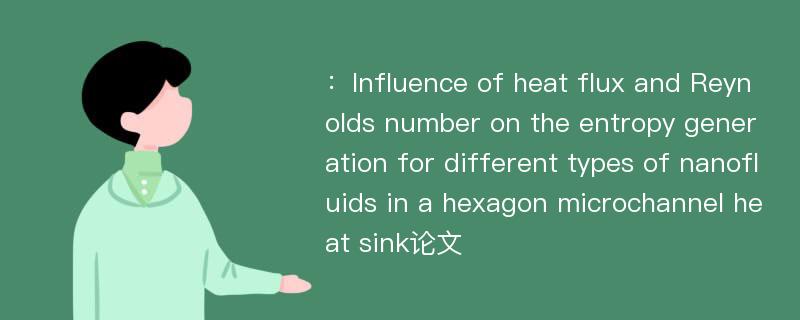
本文主要研究内容
作者(2019)在《Influence of heat flux and Reynolds number on the entropy generation for different types of nanofluids in a hexagon microchannel heat sink》一文中研究指出:Based on the Second Law of Thermodynamics, the entropy generation is studied for laminar forced convection flow of different nanoparticles(Al2O3, CuO and SiO2) mixed with water through a hexagon microchannel heat sink(HMCHS). The effects of different heat fluxes and Reynolds numbers on the entropy generation for different nanofluids, volume fractions and nanoparticles diameter are investigated. The heat flux is in the range of 125 to 500 kW·m-2 and the Reynolds numbers vary between 200 and 1500. The thermal, frictional and total entropy generations are calculated by integrating the volumetric rate components over the entire HMCHS. The results clearly show that the rise in the heat flux leads to an increase in the thermal entropy generation for nanofluids and pure water but they don’t have any influence on the frictional entropy generation. Moreover, when the Reynolds number increases, the frictional entropy generation increases while the thermal entropy generation decreases. The results revealed that at low heat fluxes and high Reynolds numbers, pure water gives the lowest entropy generation, while at high heat flux the nanofluid has to be used in order to lower the overall irreversibility.
Abstract
Based on the Second Law of Thermodynamics, the entropy generation is studied for laminar forced convection flow of different nanoparticles(Al2O3, CuO and SiO2) mixed with water through a hexagon microchannel heat sink(HMCHS). The effects of different heat fluxes and Reynolds numbers on the entropy generation for different nanofluids, volume fractions and nanoparticles diameter are investigated. The heat flux is in the range of 125 to 500 kW·m-2 and the Reynolds numbers vary between 200 and 1500. The thermal, frictional and total entropy generations are calculated by integrating the volumetric rate components over the entire HMCHS. The results clearly show that the rise in the heat flux leads to an increase in the thermal entropy generation for nanofluids and pure water but they don’t have any influence on the frictional entropy generation. Moreover, when the Reynolds number increases, the frictional entropy generation increases while the thermal entropy generation decreases. The results revealed that at low heat fluxes and high Reynolds numbers, pure water gives the lowest entropy generation, while at high heat flux the nanofluid has to be used in order to lower the overall irreversibility.
论文参考文献
论文详细介绍
论文作者分别是来自Chinese Journal of Chemical Engineering的,发表于刊物Chinese Journal of Chemical Engineering2019年03期论文,是一篇关于,Chinese Journal of Chemical Engineering2019年03期论文的文章。本文可供学术参考使用,各位学者可以免费参考阅读下载,文章观点不代表本站观点,资料来自Chinese Journal of Chemical Engineering2019年03期论文网站,若本站收录的文献无意侵犯了您的著作版权,请联系我们删除。
